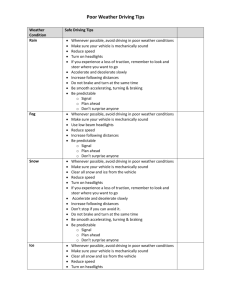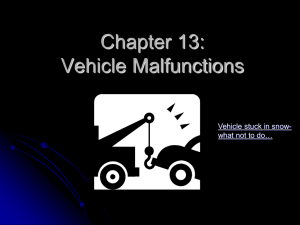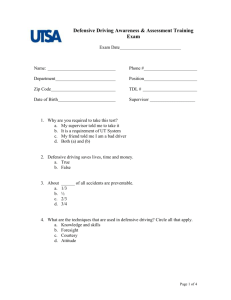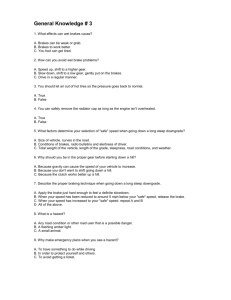Chapter 12
advertisement
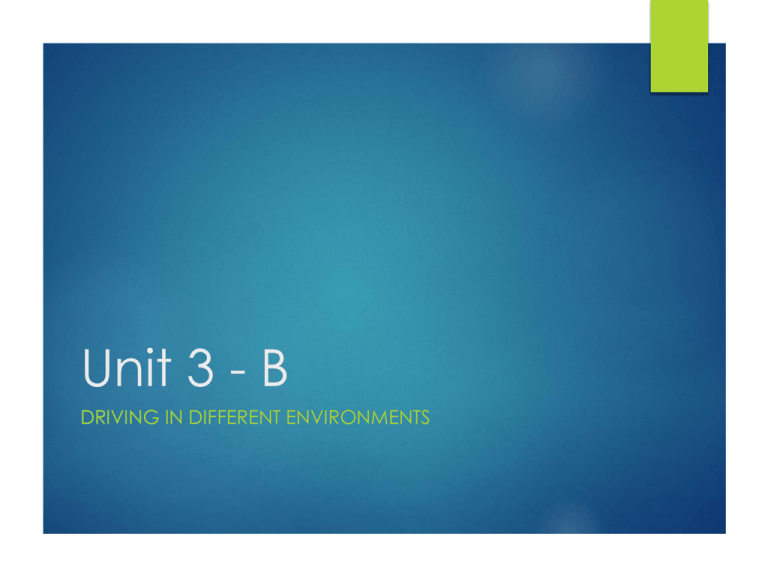
Unit 3 - B DRIVING IN DIFFERENT ENVIRONMENTS Chapter 12 12.1 – REDUCED VISIBILITY Objectives Tell how to use the IPDE process to manage risk in bad weather Explain what you can do to help others see you at dawn and dusk Describe the special techniques you can use for night driving Explain the procedure to use at night when an oncoming driver fails to use low-beam headlights. Vocabulary Overdriving headlights Your Vehicle Windows Keep it clean Defroster Rear defogger A/C and heater Open windows Vapors Smoke Sun Glare Don’t look at the sun Low beam headlights Sunglasses and visors Fall time of year Night Nighttime conditions can be more difficult Headlights Highbeam vs. lowbeam As soon as you see an oncoming car When you see headlights and taillights Use low beam in bad weather Night cont. Meeting Other Vehicles Flash headlights Move to the right, and look at the right edge Look ahead with quick, frequent glances Be ready for a hazard Overdriving Your stopping distance is greater than space illuminated by headlights Use 4 second stopping distance Fog Always use low beam headlights Slow vehicle and increase distance Be prepared to stop quickly In fog, other vehicles may be closer than you perceive. If you do have to park, do so in parking areas Rain Use wipers and defrost Illinois State Law – if wipers are on, headlights have to be on If you have to stop, do so in parking areas Snow Snow/slush/ice can build up on windows Clear all parts – headlights, all windows, tailights, etc. If you don’t have to travel, don’t Use low beam headlights 4 Wheel Drive You have more power going to wheels Not more traction Chapter 12 12.2 – REDUCED TRACTION Objectives Describes what happens to traction during rain and snow. List the steps you can take to avoid hydroplaning. Describe how to correct a rear-wheel skid. Tell how to use the controlled braking technique. Vocabulary Controlled braking Fishtail Hydroplaning Rocking a vehicle Skid Antilock braking system Traction Wet Roadways When rain starts roads can be slick Hydroplaning Tires lose contact with roadway, and rise on top of water Water, speed, and tire condition 35 mph in 1 ½ inch water Tires in poor condition = lower speeds Deep water Do not drive through standing or moving water that may touch the bottom of your vehicle Snow Snow can cause varying degrees of traction Fresh snow @ low temps = decent traction Poor traction Sub zero temps Packed snow Snow, slush, and ice Snow cont. Driving Techniques for snow Gentle accleration, braking, and steering Rocking the Vehicle Drive forward a little, and back a little Do not spin wheels Ice Be alert if it’s raining and temps. drop below freezing Water on top of ice = danger When ice melts Check traction away from traffic at low speeds Keep windows and wipers clear Ice cont. Ice on Bridges Freeze before other roadway surfaces Cold air circulates above and below the roadway on bridges and overpasses Black Ice Thin sheets of ice that are difficult to see Ice in Tire Tracks Snow can pack in tire tracks and become ice Other Reduced Traction Situations Braking distances increase in low traction areas Gravel Roads Like marbels under your tires Drive in wheel paths Leaves Wet leaves = reduced traction Construction Areas Mud, dirt, and sand on the roadway Skidding Tires lose all or part of grip on roadway Can occur while braking, accelerating, or steering Try to detect a skid early Steer in the direction you want to go This is why H-O-H and hands on outside of wheel is very important Never give up trying to correct Types of Skids Over-Power Skid Cause: Apply to much pressure to accelerator Action: Let up on the accelerator Over-Braking Skid Cause: Wheels stop moving while braking When there is no ABS Action: Let up on the brake pedal to get wheels rolling Types of Skids cont. Front wheel skid Cause: You turn the steering wheel and the vehicle goes straight ahead Understeer situation- your front wheels do not have enough traction for your vehicle to turn Action: Release pressure on the accelorator or brake Turn in the direction you want to go Types of Skids cont. Rear wheel skid Cause: You want to go straight, but vehicle is going to right or left Oversteer situation – vehicle’s rear end tends to slip out or fishtail Action: Release brake or accelorator Steer in direction you want to go Be careful not to over-correct As speed drops, control will increase Types of Skids cont. Skidding in a curve or turn Reduce speed ahead of time to avoid this If you start to skid, you will probably go off the road Controlled Braking Panic braking can cause a skid Controlled braking- reduce your speed as quickly as possible while maintaining steering control of your vehicle No ABS Heel on floor Brake, release, brake, release, etc. ABS Press on brake pedal Will not enable you to stop quicker Used in emergency situations Objectives Explain how to control your vehicle in windy conditions. List precautions for driving in extremly hot or cold conditions. Describe what to do to maintain vehicle control during winter driving. Chapter 12 12.3 – OTHER ADVERSE WEATHER CONDITIONS Wind Reduces vehicle control Blasts from passing trucks, and coming from under bridges and tunnels Stay off centerline In tornados – get out of car and lay in ditch or get under a bridge Hot Weather Temp. guage indicates when engine temp. is too hot Turn off A/C and turn on heater If engine stays hot, pull over and stop engine Check coolant levels when car has cooled off Cold Weather Be aware of exhaust leaks CO In snow make sure your exhaust pipe is not blocked Do not race cold engines Do not set parking brake Tips for Smooth Winter Driving Tests your ability to use IPDE Process Look and listen to traffic reports Keep windows clear Respect lower speeds Keep a safe following distance – increase if necessary Try to keep moving in snow Use a lower gear Avoid using cruise control Chapter 13 13.1 – VEHICLE MALFUNCTIONS Objectives List the actions to take if a tire blows out. List the proper steps to take if the brakes fail. Explain what to do if your acclerator sticks. Describe what to do incase of steering failure. Vocabulary Blowout Brake fade Jack Lug nuts Tire Failure Tires wear out Lincoln Test Wear quicker in unfavorable conditions and poor maintainence Bumps, potholes, and poor roadway surface Unbalanced wheels and poor alignment Underinflation and overinflation Blowout Tire loses air pressure suddenly Causes: hits an object or pothole, improper tire pressure Front tire Rear tire Pulls in direction of blowout Back could fishtail Two hands on the wheel at all times Blowout cont. Grip steering wheel firmly Ease off accelerator – DO NOT BRAKE Check traffic Ease off the road Brake gently Come to a stop and put on emergency flashers Changing a Tire See Handout Brake Failure Two parts One for front wheel, one for back wheel Brake warning light tells when one part has failed Total Brake Failure Rarely happens Pump the brake pedal Downshift to a lower gear Pull the parking brake lever out, and push on the parking brake Rub against the curb or sideswipe something Power brake failure – press harder Other Brake Failure Brake fade – after continuously braking hard Let the brakes cool off Driving through water Brake gently to dry the brakes Accelerator Malfunctions Not in book Broken Spring Pedal is flat on the floor Shift to neutral and pull to side of road Stuck Accelerator Kick side of pedal Apply brakes Choose an open zone off the roadway If in a curve, shift to neutral Follow escape path Turn off ignition Accelerator Malfunctions cont. Stuck Accelerator cont. Once stopped try to free pedal Remove any obstruction Tap pedal repeadedly Try to free it by pulling up on it Only do these when vehicle is stopped Engine Failure Usually little warning If you have power steering or braking it will be more difficult Shift to neutral and move towards the curb Don’t brake – try to restart while vehicle is still moving If it does not continue to move out of traffic and stop Call for help Overheated Engine Hot weather, stop and go traffic, driving up hills with A/C on Temp. gauge or light Turn off A/C and turn on heater At stops, shift to neutral and press gently on accelerator If engine stays hot, pull to a safe place, stop, and turn off engine Do not work on a hot engine Steering Failure Total Steering Failure Honk horn and turn on emergency flashers Take foot off accelerator – do not brake Use emergency on/off method Shift to a lower gear Power Steering Failure Still works, just need more effort Loss of Forward Vision Hood Flies Up Look below the crack in the open hood Roll down your window and look out it Turn on emergency flashers and tap brakes Slow down and move out of traffic Headlights Fail Turn on right turn signal Slow down and bring vehicle to a stop Try other lights – dimmer, parking, hazards Use street lights Splashed Windshield Turn over on wipers and try to clear windshield – pull Vehicle on Fire Pull over immediately into a safe area Turn off ignition Get everyone out and away from the vehicle Leave the hood closed Call the fire department Vehicle Stalls on Railroad Track Get out of vehicle Call for help If train approaches – run in the direction of the train Chapter 13 13.2 – DRIVER ERRORS Objectives Describe how to return to the roadway if your vehicle runs off the roadway. Explain when to use an emergency swerve. Vocabulary Countersteer Driving Off the Road Front wheel leaves the edge of the roadway Easy if shoulder is paved and even with the roadway Off Road Recovery 2 wheels off the road Grip the steering wheel firmly Let off the accelerator Let the car start to slow on its own Check traffic around you Ease the car back on the road The greater the drop off, the more careful you have to be Be careful not to oversteer – countersteer if you do oversteer Emergency Swerving Last second attempt to avoid a collision It may take more distance to stop than it would to swerve Over 30 Make sure there is no object or vehicle in the lane you want to swerve into Braking hard could lock the wheels and send you into the object or vehicle in front Emergency Swerving cont. Identify path Grip wheel firmly Steer quickly in the direction you want to go and then countersteer Consider distance and speed Increased speed = less time and space Chapter 13 13.3 – ROADWAY HAZARDS Objectives Describe how to minimize vehicle damage caused by potholes. Explain what to do if you enter a curve too fast. Tell how to escape from a vehicle that is sinking in water. Potholes in the Roadway Water in cracks freezes and thaws Potholes can cause major wheel damage If you must drive through a pothole, slow down Sharp Curve May not be marked or have limit sign advisory speed Brake gently as soon as you realize problem If not yet in the curve brake more firmly About ½ way through, accelerate gently to help stabilize the vehicle Object in the Roadway Never hit an object in the roadway Check around you Decide to: Brake Steer around Straddle Vehicle in Deep Water Open windows Unfasten seatbelt Exit the vehicle If vehicle is totally submerged, you will have to let the vehicle fill with water first Chapter 13 13.4 - COLLISIONS Objectives Explain how to minimize or avoid head-on, sideimpact, and rear-end collisions. List the immediate steps to take if a collision occurs Describe other follow up steps needed after a collision Minimize Effects of a Collision Do not give up – keep control of the vehicle Aim for something soft Avoid trees, parked vehicles, poles If threat of another vehicle colliding, get out and away Threat of a Head-On Collision Maintain vehicle control Brake gently and quickly Blow horn and flash light Steer to the right Threat of Side-Impact Collision Brake or accelerate quickly Blow horn Changes lanes or swerve into another lane if possible Threat of a Rear-End Collision Flash brake lights Pull forward if possible Turn right if possible Enter the intersection Release brakes just before impact If You Have a Collision Stop immediately Aid the injured Prevent further damage Send for the police Exchange information Additional Steps Record witness names and addresses Give police the facts File necessary reports Chapter 13 Insurance Financial responsibility law Requires you to prove that you can pay for damages you cause that result in death, injury, or property damages You buy insurance from a company by paying a premium Premium- a specified amount of money for coverage over a specified period of time. Policy A written contract between you-the insured-and the insurance company Many different kinds of insurance. Liability insurance: covers others when you are at fault in a collision. Collision insurance: provides coverage to pay the costs of repair or replacement of your vehicle, minus the deductible. Deductible: amount you agree to pay towards the repair or replacement of your vehicle Page 268 for vehicle insurance Insurance Rates Factors: Driving record Age Miles driven Driver’s gender Marital status Type of vehicle Address Driver’s claim record

